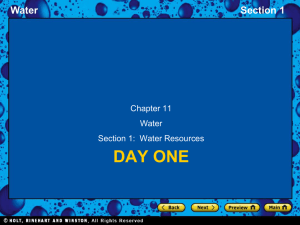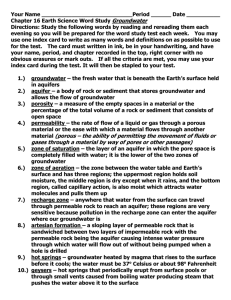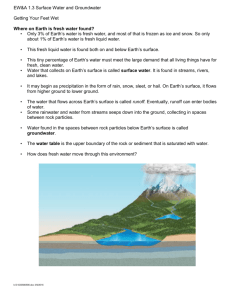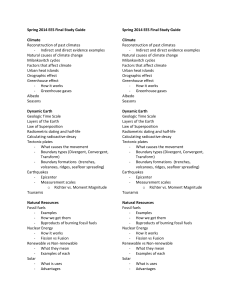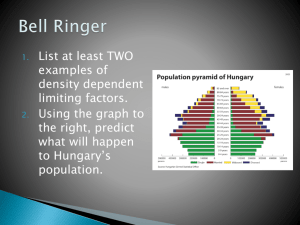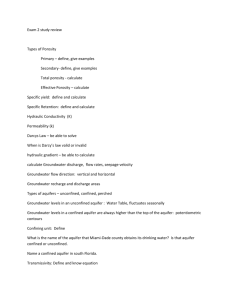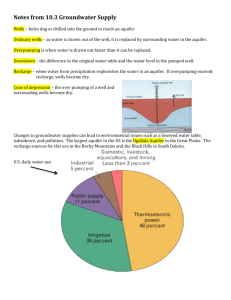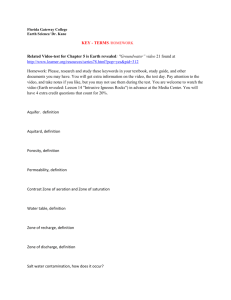NOTES: Chapter 11.1
advertisement
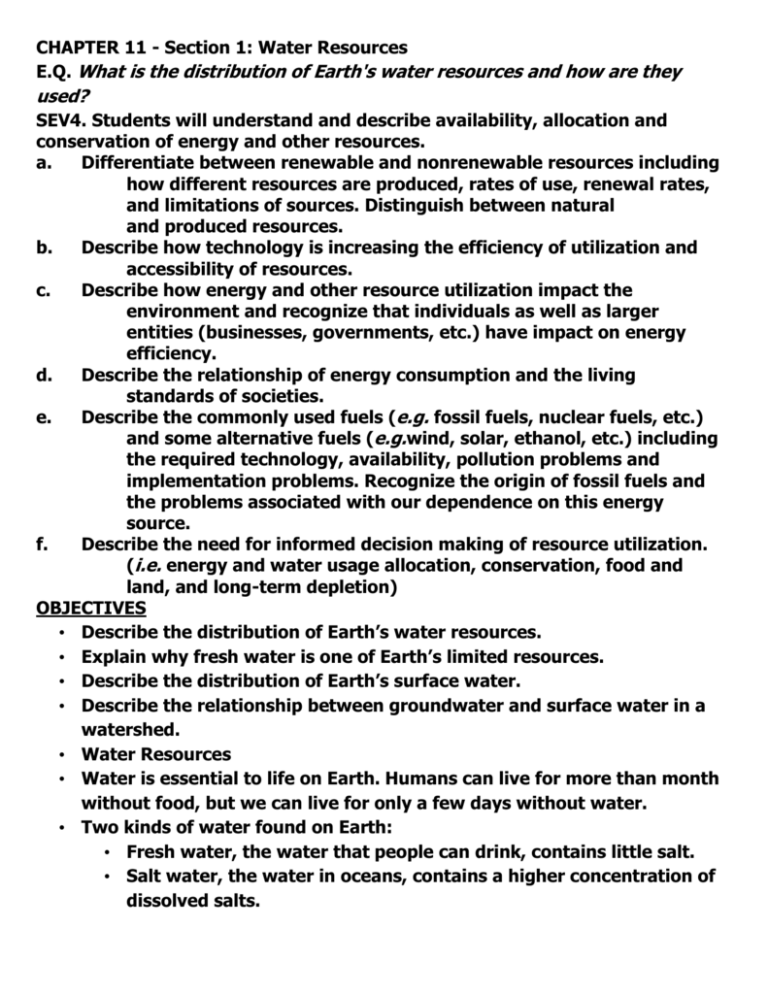
CHAPTER 11 - Section 1: Water Resources E.Q. What is the distribution of Earth's water resources and how are they used? SEV4. Students will understand and describe availability, allocation and conservation of energy and other resources. a. Differentiate between renewable and nonrenewable resources including how different resources are produced, rates of use, renewal rates, and limitations of sources. Distinguish between natural and produced resources. b. Describe how technology is increasing the efficiency of utilization and accessibility of resources. c. Describe how energy and other resource utilization impact the environment and recognize that individuals as well as larger entities (businesses, governments, etc.) have impact on energy efficiency. d. Describe the relationship of energy consumption and the living standards of societies. e. Describe the commonly used fuels (e.g. fossil fuels, nuclear fuels, etc.) and some alternative fuels (e.g.wind, solar, ethanol, etc.) including the required technology, availability, pollution problems and implementation problems. Recognize the origin of fossil fuels and the problems associated with our dependence on this energy source. f. Describe the need for informed decision making of resource utilization. (i.e. energy and water usage allocation, conservation, food and land, and long-term depletion) OBJECTIVES • Describe the distribution of Earth’s water resources. • Explain why fresh water is one of Earth’s limited resources. • Describe the distribution of Earth’s surface water. • Describe the relationship between groundwater and surface water in a watershed. • Water Resources • Water is essential to life on Earth. Humans can live for more than month without food, but we can live for only a few days without water. • Two kinds of water found on Earth: • Fresh water, the water that people can drink, contains little salt. • Salt water, the water in oceans, contains a higher concentration of dissolved salts. • Most human uses for water, such as drinking and agriculture, require fresh water. THE WATER CYCLE • Water is a renewable resource because it is circulated in the water cycle. • In the water cycle, water molecules travel between the Earth’s surface and the atmosphere. Water evaporates at the Earth’s surface. Water vapor rises into the air. As the vapor rises, it condenses to form clouds. Eventually the water in clouds falls back to the Earth. • The oceans are important because almost all of the Earth’s water is in the ocean. GLOBAL WATER DISTRIBUTION • Although 71 percent of the Earth’s surface is covered with water, nearly 97 percent of Earth’s water is salt water in oceans and seas. • Of the fresh water on Earth, about 77 percent is frozen in glaciers and polar icecaps. • Only a small percentage of the water on Earth is liquid fresh water that humans can use. • Global Water Distribution • The fresh water we use comes mainly from lakes and rivers and from a relatively narrow zone beneath the Earth’s surface. SURFACE WATER • Surface water is all the bodies of fresh water, salt water, ice, and snow, that are found above the ground. • The distribution of surface water has played a vital role in the development of human societies. • Throughout history, people have built cities and farms near reliable sources of water. Today, most large cities depend on surface water for drinking water, water to grow crops, food such as fish, power for industry, and transportation. RIVER SYSTEMS • Streams form as water from falling rain and melting snow drains from mountains, hills, plateaus, and plains. As streams flow downhill, they combine with other streams and form rivers. • A river system is a flowing network of rivers and streams draining a river basin. • The Amazon River system is the largest river system in the world as it drains an area of land that is nearly the size of Europe. WATERSHEDS • A watershed is the area of land that is drained by a water system. • The amount of water that enters a watershed varies throughout the year. • Rapidly melting snow as well spring and summer rains can dramatically increase the amount of water in a watershed. At other times of the year, the river system that drains a watershed may be reduced to a trickle. GROUNDWATER • Most of the fresh water that is available for human use cannot be seen, as it exists underground. • When it rains, some of the water that falls onto the land flows into lakes and streams. But much of the water percolates through the soil and down into the rocks beneath. • Groundwater is the water that is beneath the Earth’s surface. • As water travels beneath the Earth’s surface, it eventually reaches a level where the rocks and soil are saturated with water. This level is known as the water table. • In wet regions, the water table may be at Earth’s surface. But in deserts, the water table may be hundreds of meters beneath Earth’s surface. • The water table has peaks and valleys that match the shape of the land above. Groundwater tends to flow slowly from the peaks to the valleys. AQUIFERS • An aquifer is a body or rock or sediment that stores groundwater and allows the flow of groundwater. They are an important water source for many cities. • The water table forms the supper boundary of an aquifer, and most aquifers consist of materials such as rock, sand, and gravel that have a lot of spaces where water can accumulate. • Groundwater can also dissolve rock formations, filling vast caves with water, creating underground lakes. POROSITY • Porosity is the percentage of the total volume of a rock or sediment that consists of open spaces. • Water in an aquifer is stored in the pore spaces and flows form one pore space to another. • The more porous a rock is, the more water it can hold. PERMEABILITY • Permeability is the ability of a rock or sediment to let fluids pass through it open spaces or pores. • Materials such as gravel that allow the flow of water are permeable. Materials such as clay or granite that stop the flow of water are impermeable. • The most productive aquifers usually form in permeable materials, such as sandstone, limestone, or layers of sand and gravel. THE RECHARGE ZONE • To reach an aquifer, surface water must travel down through permeable layers of soil and rock. Water cannot reach an aquifer from places where the aquifer is covered by impermeable materials. • The recharge zone is an area in which water travels downward to become part of an aquifer. • Recharge zones are environmentally sensitive areas because any pollution in the recharge zone can also enter the aquifer. THE RECHARGE ZONE • The size of an aquifer’s recharge zone is affected by the permeability of the surface above the aquifer. • Structures such as buildings and parking lots can act as impermeable layers and reduce the amount of water entering an aquifer. • Communities should carefully manage recharge zones, because surface water can take a very long time to refill an aquifer, even tens of thousands of years. WELLS • A hole that is dug or drilled to reach groundwater is called a well. • Humans have dug wells to reach groundwater for thousands of years. • We dig wells because ground water may be a more reliable source of water than surface water and because water is filtered and purified as it travels underground. • The height of the water table changes seasonally, so wells are drilled to extend below the water table. • If the water tables falls below the bottom of the well during a drought, the well will dry up. In addition, if groundwater is removed faster than it is recharged, the water table may fall below the bottom of a well. • To continue supplying water, the well must be drilled deeper.

